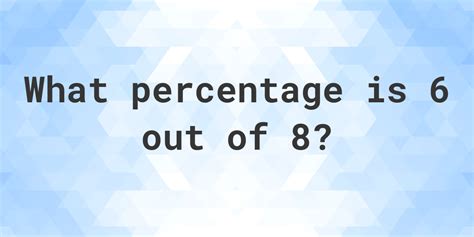What Is 6 8 As A Percent
Kalali
Mar 28, 2025 · 4 min read

Table of Contents
What is 6/8 as a Percent? A Comprehensive Guide to Fraction-to-Percentage Conversion
Understanding how to convert fractions to percentages is a fundamental skill in mathematics with widespread applications in various fields, from everyday budgeting to complex financial analysis. This comprehensive guide will delve into the process of converting the fraction 6/8 into a percentage, explaining the steps involved and providing further examples to solidify your understanding. We'll explore different methods, address common misconceptions, and demonstrate the practical relevance of this conversion.
Understanding Fractions and Percentages
Before we dive into the conversion, let's briefly review the concepts of fractions and percentages.
Fractions: Representing Parts of a Whole
A fraction represents a part of a whole. It's expressed as a ratio of two numbers: the numerator (top number) and the denominator (bottom number). The numerator indicates the number of parts you have, while the denominator indicates the total number of parts the whole is divided into. In our case, the fraction 6/8 means we have 6 parts out of a total of 8 parts.
Percentages: Expressing Parts per Hundred
A percentage is a way of expressing a number as a fraction of 100. It's denoted by the symbol "%". For instance, 50% means 50 out of 100, or 50/100. Percentages are widely used because they provide a standardized way to compare proportions.
Converting 6/8 to a Percentage: Step-by-Step Guide
There are several methods to convert a fraction to a percentage. Let's explore the most common approaches:
Method 1: Simplifying the Fraction and then Converting
The first step is to simplify the fraction 6/8. Both the numerator (6) and the denominator (8) are divisible by 2. Simplifying the fraction gives us:
6/8 = 3/4
Now, to convert the simplified fraction 3/4 to a percentage, we need to find an equivalent fraction with a denominator of 100. We can achieve this by multiplying both the numerator and the denominator by a number that will result in a denominator of 100. Since 4 multiplied by 25 equals 100, we multiply both the numerator and the denominator by 25:
(3 * 25) / (4 * 25) = 75/100
Since a percentage is a fraction out of 100, 75/100 is equivalent to 75%.
Method 2: Converting the Fraction to a Decimal and then to a Percentage
Another method involves first converting the fraction to a decimal and then converting the decimal to a percentage.
To convert the fraction 6/8 to a decimal, we simply divide the numerator (6) by the denominator (8):
6 ÷ 8 = 0.75
To convert a decimal to a percentage, we multiply the decimal by 100 and add the "%" symbol:
0.75 * 100 = 75%
Therefore, 6/8 is equal to 75%.
Method 3: Using Proportions
This method utilizes the concept of proportions to solve for the percentage. We can set up a proportion:
6/8 = x/100
To solve for x (the percentage), we cross-multiply:
8x = 600
Then, divide both sides by 8:
x = 600 ÷ 8 = 75
Therefore, x = 75, meaning 6/8 is 75%.
Practical Applications of Fraction-to-Percentage Conversion
The ability to convert fractions to percentages is crucial in many real-world scenarios:
- Calculating Grades: If you answered 6 out of 8 questions correctly on a test, your score would be 75%.
- Determining Discounts: A store offering a 6/8 discount (equivalent to a 75% discount) is offering a substantial price reduction.
- Analyzing Financial Data: Investors often use percentages to analyze financial performance, such as return on investment (ROI). Understanding fraction-to-percentage conversion helps in interpreting such data.
- Understanding Statistical Data: Percentages are essential for representing and understanding statistical data, such as survey results or population demographics.
- Baking and Cooking: Many recipes use fractions, and understanding their percentage equivalents allows for easy adjustments to recipe sizes.
Common Misconceptions and Troubleshooting
- Forgetting to Simplify: Always simplify the fraction before converting it to a percentage. This simplifies the calculation and reduces the chance of errors.
- Incorrect Decimal-to-Percentage Conversion: Remember to multiply the decimal by 100 to convert it to a percentage. Forgetting this step leads to inaccurate results.
- Confusing Numerator and Denominator: Always ensure you are dividing the numerator by the denominator when converting a fraction to a decimal.
Further Examples of Fraction-to-Percentage Conversion
Let's solidify our understanding with some additional examples:
- 1/2: 1/2 = 0.5 * 100 = 50%
- 3/5: 3/5 = 0.6 * 100 = 60%
- 2/3: 2/3 ≈ 0.6667 * 100 ≈ 66.67% (Note the use of approximation for recurring decimals)
- 7/10: 7/10 = 0.7 * 100 = 70%
- 5/8: 5/8 = 0.625 * 100 = 62.5%
Conclusion: Mastering Fraction-to-Percentage Conversion
Converting fractions to percentages is a valuable mathematical skill with numerous practical applications. Understanding the different methods—simplifying the fraction, converting to a decimal, and using proportions—allows you to choose the most efficient approach based on the given fraction. By mastering this skill, you'll enhance your mathematical abilities and be better equipped to tackle various quantitative challenges in your personal and professional life. Remember to always double-check your work and utilize the method that you find most comfortable and efficient. Practice makes perfect, so keep working through examples to build your confidence and fluency.
Latest Posts
Latest Posts
-
How Many Inches Are 14 Cm
Mar 31, 2025
-
How Many Centimetres In 2 Metres
Mar 31, 2025
-
How Many Meters Is 2 Kilometers
Mar 31, 2025
-
How Long Does Granular Fertilizer Last In Soil
Mar 31, 2025
-
How Many Ounces Is One Kilogram
Mar 31, 2025
Related Post
Thank you for visiting our website which covers about What Is 6 8 As A Percent . We hope the information provided has been useful to you. Feel free to contact us if you have any questions or need further assistance. See you next time and don't miss to bookmark.
